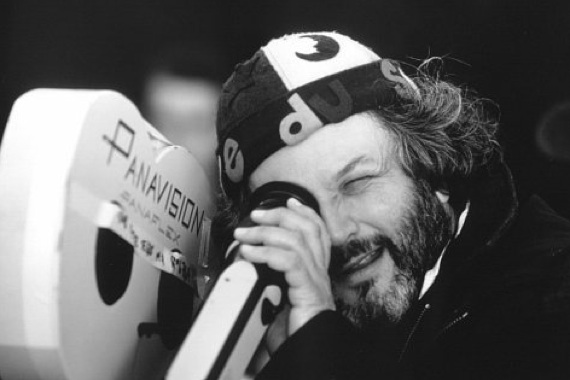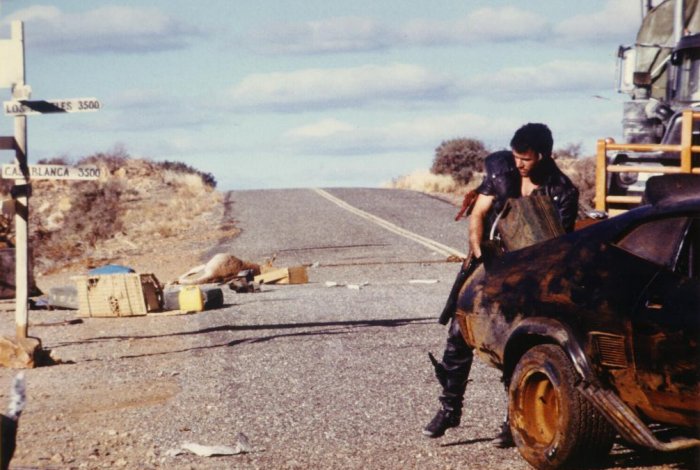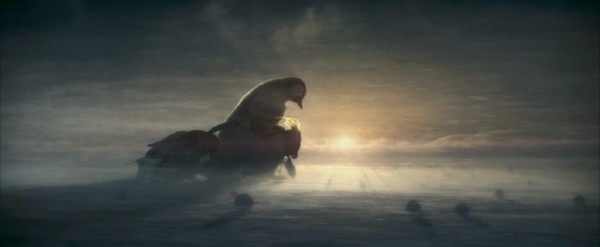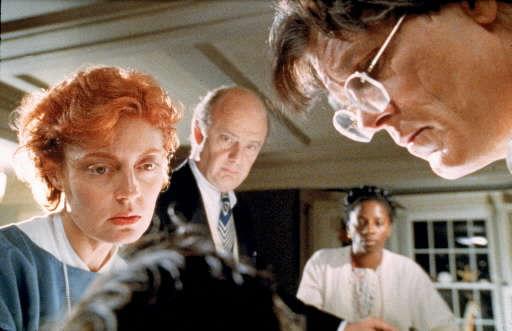
Sven: Hello, my name is Sven. I operate the blog Sadness? Euphoria? at ijustknowit.blogspot.com . The Filmist here invited me to do a dialogue about George Miller, a filmmaker that both of us have claimed as among the greats. Forgive me if I come off awkwardly, but this is the first time I've done anything like this. (This is what we're doing, right?) Should you introduce yourself? Then I'll start with a comment/question about Miller himself.
The Filmist: Hey, how's it going? I'm The Filmist. I operate The Filmist at 'thefilmist.wordpress.com.' I'm currently engaged in this Miller-centric discussion. And, now the floor belongs to Sven.
Sven: So... Miller is one of those filmmakers that I found very early in my career as an avid film hobbyist, around fifteen or sixteen. I saw, duh, The Road Warrior and like just about everyone, I just about died from how great, how exciting, how fast, how fun, and how resonant film could be. I was pleased to find that Miller was able to keep his same formal dynamism, which is of particular interest to me and how I watch films, running throughout his less action-oriented films as well. What about you? How long have you been digging on Miller?
The Filmist: I came upon Miller when I was, I think, the same age as you. My brother - who's one of the guys I really credit with introducing me to film - put on the first "Mad Max," and I think that's also what kind of intrigued me about the films initially, is there's an orchestration about them. They build, like a piece of music. Later on, I saw "The Road Warrior," and it was a marked improvement on that first film - the first "Mad Max," I've always thought, was a film with a lot of great ideas, but there are times where it shows through through that it's Miller's first real film.

Sven: To prep myself for this conversation I recently rewatched The Witches of Eastwick and what you say about his image orchestration is applicable tenfold to that film. I've never seen a film that so consciously operated as a silent film as The Witches of Eastwick. The framing, pacing, acting style... it was very interesting.
The Filmist: You know, Witches of Eastwick really is the odd-man-out, in his oeuvre. There's very little of the archetypal storyline that seems to run throughout the rest of his stuff - minus the first "Mad Max." Which isn't a bad thing, don't get me wrong. But, among stuff like "Beyond Thunderdome," and even "Babe: Pig In the City," a black domestic comedy really pokes its head out. I do kind of wonder what his filmography would look like, it he hadn't been scared away from Hollywood during its production.
Sven: I would've agreed with you had I not recently rewatched Witches which definitely seems to have more in line with Babe Pig in the City and Beyond Thunderdome than does Lorenzo's Oil. Graphically, it's very strong, relying entirely on the weight of mythic imagery to develop the narrative and characters. Lorenzo's Oil is a fairly strong medical procedural, but is lacking in the icon front. Mostly it's just fairly typical shots of the Odones sitting around frustrated.
The Filmist: It is less kinetic than the rest of his filmography, I agree - those upstarts here and there notwithstanding. I can see the relation between "Pig In the City" and "Eastwick," I suppose - there's actually a couple of motifs shared between the two, I noticed. Like the balloons.
Sven: Yeah, the balloons was obvious. A very easy way to create a dynamic visual, and I'm not sure why it's there in Eastwick. That scene of Nicholson dancing around with them is a pretty strange way to communicate the seduction, particularly since they're already hooked at that point. Still, I love the look of it. Anyway, we both started with the Mad Max movies. Let's talk a little bit about those. How would you relate each of them to the other? It's a pretty strange trilogy.

The Filmist: Altogether, certainly. That's one of the things I most enjoy, really - that they're all so stylistically distinct from one another, as standalone films. "Mad Max," like a lot of people have mentioned, is a lot more in the vane of things like "Dirty Harry," or any of those kinds of films, while the other two have a far wider scope. There's a gradual segue from the realistic, in "Mad Max," to the hyperbolic and allegorical, in "Thunderdome."
Sven: What I think is remarkable about their structure is that the last one essentially constructs the telling of the tale, which is the second film, which is based on the reality of the events in the first film. If that makes sense. It's all varying levels of interpretation of of the Lone Hero theme, with increasing wit and formal dynamism.
The Filmist: Oh, sure. "The Road Warrior" is, essentially, the quintessential archetype, while "Thunderdome" actually examines it in the context of the children in the "Crack In the Earth." It's funny, while we're talking about "Thunderdome," because I was reading a piece by that French critic Rafik Djoumi a while back, and he brought up something that actually caught my eye - Miller's latest film, "Happy Feet," actually reuses many of the symbols and narrative iconography that appear here. He says:
"It includes the religious world, hierarchical folded its rituals (the Thunderdome - Emperor penguins), but with the master of ceremonies deprived, who dressed his suffering an aura of mystique (the dwarf "The Master" - the guru Lovelace ), but with the group of "small" which alone can lead to the ancient city of men (children of the tribe - the tribe of penguins). "
Sven: Hmmm... I have to admit that it seems like a bit of a stretch, though I don't deny that Miller is applying a similar mythological rigor to both pieces. And really, let's be honest... Mumble is no Mad Max.
The Filmist: I don't know, I think it's pretty conscious - in keeping with that, there's also the physical look of some of the characters in relation with each other, like the elder character with Scrooloose. Also - Happy Feet 2: Beyond Mcmurdome. You know you'd go to see it.
Sven: Ha ha. Of course I would! At any rate, then, Happy Feet... why do you love it so much?

The Filmist: Oh, there's a couple of reasons, I think - but, partly because it's so astonishing that Miller was able to take what is essentially a screensaver concept and turn it into this broad-scale epic.
Sven: Cosmic-scale, I'd say. I love the way the film opens, with all those stars and nebulas and stuff. And when Mumble is screeching when he's stuck in the zoo and there is that quick series of zoom outs into space. Love that..
The Filmist: The 'space' motif of the film is also really intriguing, I think - partly because of it's finished application in the film, and because of it's origin. In the finished film, it serves a couple of purposes - from the beginning, it really serves to underline the nature of the story, as a real 'fable -' the faint outlining of a mother penguin in the nebula, and then the rotation of the Earth until Antarctica is on top of the world, where it stays front and center for the entirety of the film, whenever we get a good look at it. In the book, "Variety's This Movie Changed My Life," that astrophysicist Neil Tyson says of it:
"From its opening scene, you come at Earth from space and the Earth rotates so that Antarctica is on top of the world. From the beginning it establishes a point of view, and you are in the culture of the penguins whose food supply is disappearing, and they have to pray to the food gods."
But - and I posted about this a while back - I've also been doing a little digging, here and there.
It seems that there was an entire half-hour or so cut out of the film, actually, and an entire plotline cut out of the film, featuring honest-to-bob aliens that looked a lot like the penguin god that we saw at the beginning of the film. From what I've been hearing from some of the animators, it was actually a pretty big deal. But, the only thing that remains in the final film is the space shots.
Sven: Whoa. Weird. And all that stuff was animated? Or was it taken out in an earlier stage...?
The Filmist: Some have told me that it was animated, finished, and cut out at the last minute. Others have said that it was cut out, earlier. So, I'm not particularly sure, but I'd probably put my money on it being cut out at the last second, given the presence of the space shots in the film. There was even concept art and footage shown from these segments at a presentation about the film in 2007, but so far that's the only time.
Sven: ...I wonder if that angle will be incorporated into the hypothetical Happy Feet 2.
The Filmist: That's what I've been thinking, actually. For my part, I'd rather see this original cut of the film, wherever it is.
Sven: If it exists, sure, but I think I'd be hard-pressed to think that such an addition to the film as it is would be at all an improvement. I love the way the cosmos are used expressively. It would feel somewhat banal to re-register those shots as foreshadowing the arrival of aliens.
The Filmist: Well, I can agree with that. Most especially in that wide-pull out in the zoo scene that you mentioned.
Sven: And I would think that it would be hard to rewrite the film's message on an even more macro-scale than it already is. What would aliens have to do with overfishing?
The Filmist: Apparently, it was going to be a three-layered story, as this goes. One of the animators wrote up a short summary, let me find it:
"The aliens themselves looked rather like ethereal penguins. Glowy and slender… translucent. And by observing what happens on Earth and seeing Mumble and his interactions with the humans, they withdraw their weapons and leave us in peace. The story was setting itself up for this and if you’ve seen the film, this is the reason why it seems as if something was missing. The decision to ditch the aliens was made towards the final stages of production. As I said before, the suits from WB just didn’t get it. They insisted on it’s removal from the film. Perhaps they were right but I always felt the original story was going to be three layered and not two. As it stood, the Humans were harvesting the fish and it was affecting the Penguins… when at the same time, the aliens were harvesting the planet and Mumble was to save all of us. The end version worked although it seemed to be missing something. Probably this is why it felt there was a hole in the general flow of the story."
If this were to be somehow released, I think it would be a case similar to the multiple cuts of "Blade Runner;" I'd probably enjoy them both, for different reasons.
Sven: Well, I certainly would leave it to Miller to make such a strange concept work. We'll see what he does with Happy Feet 2.
The Filmist: Oh, indeedy. Even if it does take a couple of years. What intrigues me is the aliens resemblance to the penguin god - now, what could that mean?
Sven: What that reminds me of is the pig-looking judge in Babe: Pig in the City. That always baffled me.
The Filmist: That's what I thought, actually. The first time I read it. So, you'd said you just finished rewatching "Lorenzo's Oil?"

Sven: Yeah. It was one of my favorites a while back, but upon rewatching it, it seemed a bit weak. I say Bravo! to Nolte for doing the Italian thing, and it's a very compassionate film--I particularly like the way Ustinov's character is poised on the edge between scientific detachment and humanistic empathy. But I think it may be a bit too simplistic, formally. Sometimes it felt like a made for TV film. Which made the occasional flourish of the camera kind of jarring.
The Filmist: The only time I really got that kind of impression was during the montage, over the end-credits, which really did feel unneeded. I mean, certainly - show the impact the Odones have had, but that seemed like such a televised way to do it.
Sven: Well, it's tough, I think, because the impulse is to let a little bit of the non-fiction seep into your interpretation, and how best to do that then to conclude with documentary footage? It reminded me of Schindler's List a bit, and I don't know if I would claim that the epilogue on that on is all that tacky aesthetically. But then, that one was filmed a bit more expressively, whereas in Lorenzo's Oil it's just a montage of pretty flatly shot talking heads.
The Filmist: Well, here and there, I suppose. But, I do think Miller works better on that mythological scale, "Witches of Eastwick" notwithstanding. Although, then again, there's The Dismissal, which he also directed.
Sven: I do not know The Dismissal. I would like to see it at some point.
The Filmist: The Dismissal is great, but it's damnably hard to find. I've only seen the three episodes once before. Personally, what always stood out for me, with "Lorenzo," was the use of stark angles and the way Miller adapted his trademark kineticism (my word), throughout - most of the time in a two-room house.
(End of Segment One. In Segment Two, which should be up relatively soon, we'll be looking at the recurring themes and visual motifs, throughout Miller's filmography. Or, at least that's the jumping off point.)
No comments:
Post a Comment